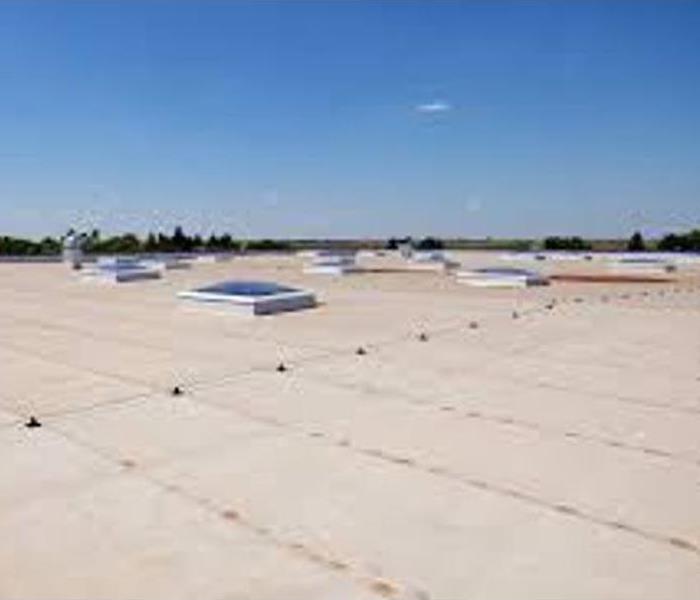Choosing The Best Materials For Your Commercial Roof
4/5/2022 (Permalink)
 Choosing the right roof for your commercial business can be essential, especially when it prevent water damage and fire prevention.
Choosing the right roof for your commercial business can be essential, especially when it prevent water damage and fire prevention.
You need to choose the material that is best suited to the specific needs for your commercial roof. This process can be challenging. Commercial buildings have properties and designs that are quite different from standard residential properties.
If you are looking for materials for your commercial building, the following tips will help:
1. The current state of your existing structure
The first thing to look at that will help you choose the best material for your situation is the current physical state of your existing commercial roof. You should take into account the roof type, accessibility, protrusions and any structures like fire mitigation systems or HVAC housing. All of these factors will help you decide on the best material for your commercial roof.
Additionally, you can sometimes install a new commercial roof on top of an existing roof. This will save you the cost and time of taking down the existing roof. However, it is not always possible to put one roof directly on top of another.
Furthermore, you should take into consideration existing structures like skylights, vents and AC units. These systems can affect the installation and maintenance process of a different type of commercial roof. Also, you should consider foot traffic as it is likely that people may have to walk on the roof. This will ensure the safety of both your roof and the employees in the building.
2. Its location and climate
The physical location of a building is another important factor in choosing the best materials for your commercial roof. You should take into account the expected extreme weather conditions for that climate, nearby hazards like wildlife or overhanging trees, and local building codes. Different climates may require different types of commercial roofs for a building.
Additionally, a metal roof, because of its durability, may be well-suited for buildings that see a lot of hail and snow. On the other hand, a reflective-type roofing system would be desirable for buildings in a desert climate. This will help in energy efficiency, and Flexion is a good option. EPDM is another material that is good for buildings in climates with both extreme cold and heat.
Furthermore, two buildings in different locations may benefit from the same type of roofing systems for different reasons. TPO’s energy-efficient properties may be beneficial to a building in an urban setting. Likewise, the puncture resistance and tensile strength of TPO make it a good choice for buildings surrounded by trees with very low branches.
3. The type of business
The type of business that the building will be used for is another factor to consider when you want to get the best material for your commercial roof. The heating and cooling needs of a storage warehouse will be vastly different from that of a retail clothing store.
Energy-efficient systems like TPO or Flexion will be a good choice for a retail store where the customers expect a comfortable and moderate temperature. In contrast, EPDM, a less energy-efficient option, will be a good choice of material for warehouse inventories that are not temperature sensitive.
Buildings, housing manufacturers, and restaurants need a roofing system that can accommodate exhaust and ventilation systems. Buildings like this may require PVC, a material that can withstand damage from oils and chemicals. TPO and EPDM would be a poor choice, as they are both roofing materials that can degrade when exposed to these substances.
4. Impact on the environment
Another factor that will help you choose the best material for your commercial roof is the environmental impact it will have. You may want to look at roofing systems whose materials can be recycled when they have outlived their lifespan.
The reflectiveness of the material is another property as well; It could be able to accommodate green features like photovoltaic panels or additional insulation. The green options are more energy-efficient and subsequently, come with a lower utility cost.
5. Your budget
A commercial roof is a significant investment. However, your choice will inevitably be determined by your budget. Nevertheless, a commercial roof is an important investment, and you need to put more than the initial price tag into consideration. This way you will truly understand its value.
Additionally, the true lifetime cost of the commercial roof should also be considered. This may include factors like available warranties, longevity, repairs, and future maintenance.
In many cases, the lifespan of roofing materials that are less expensive is shorter. Such roofing materials would require frequent materials or repairs, which could prove more expensive in the long run.
6. Plan of the building
Different roofing systems have different longevity. This contributes to plans when choosing the best material for your commercial roof. Different commercial roofs can offer lifespans ranging between 10 to 50 years with proper maintenance and care.
Commercial buildings will most likely be around for decades. Most businesses would want a roofing system with a long life expectancy. However, owners of a property may not want to put a commercial roof on when they plan to sell the property soon. Although they know that is a long-lasting investment, they may not want to do it because of the high cost.





 24/7 Emergency Service
24/7 Emergency Service